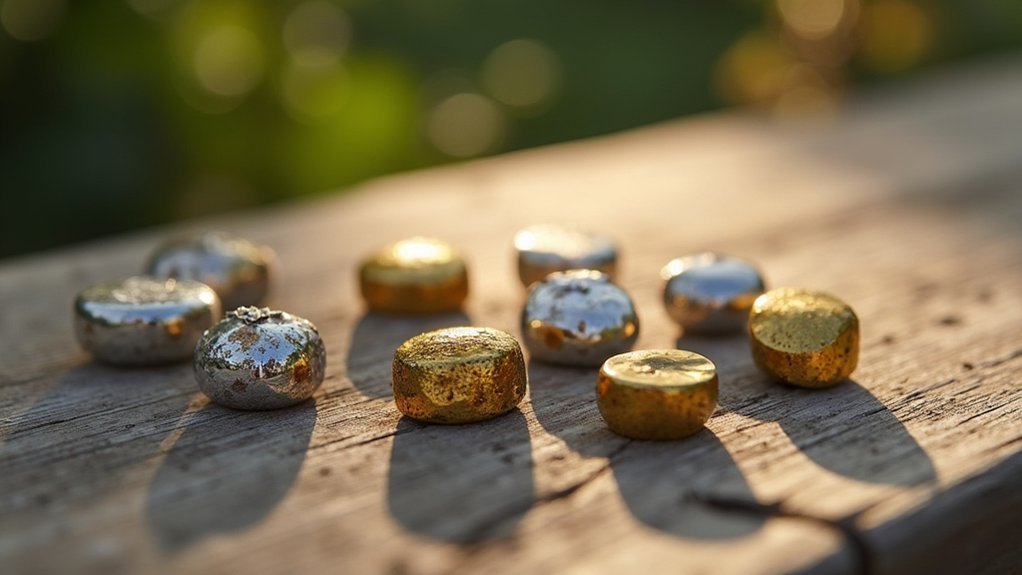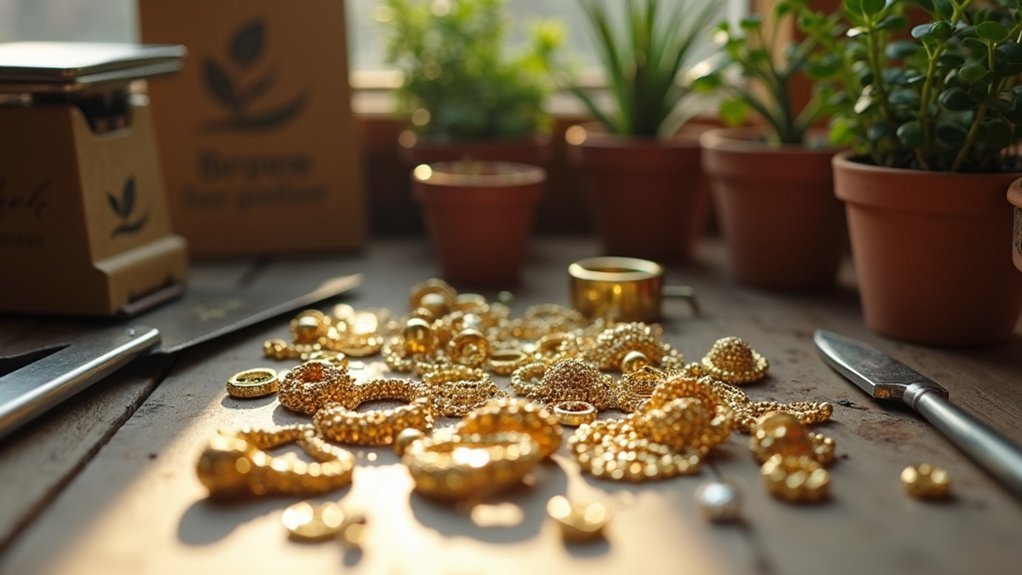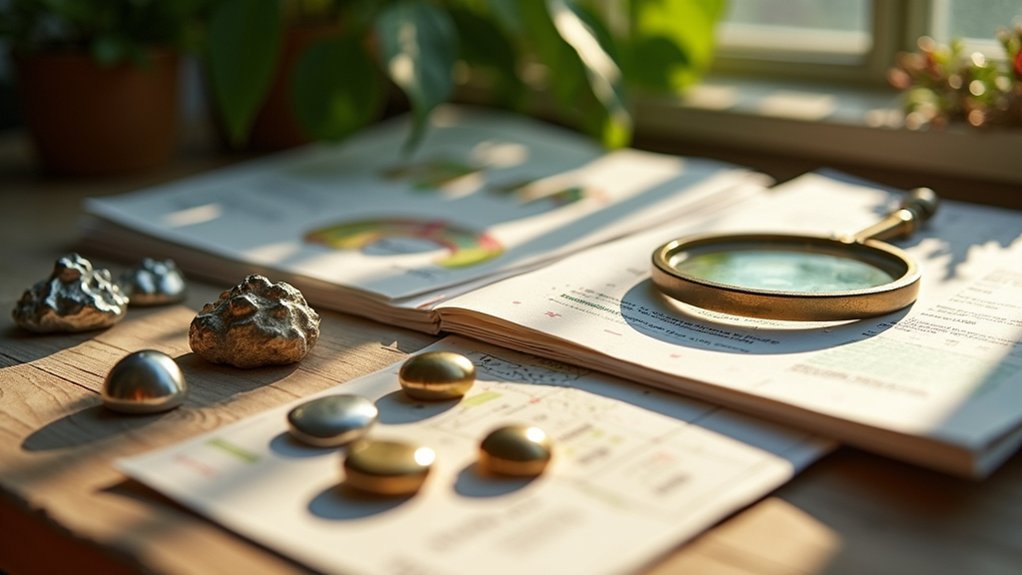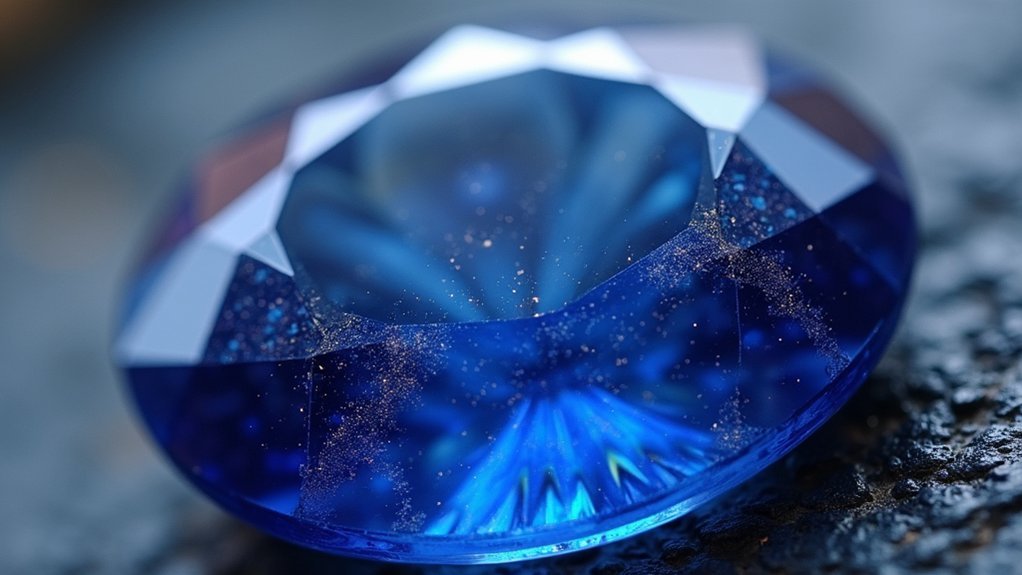You can source eco-friendly metals for jewelry by partnering with certified suppliers offering Fairmined, Fairtrade, or Responsible Jewelry Council certifications. Focus on recycled gold and silver, which reduce environmental impact by 90% and save approximately 20 tons of earth displacement per wedding ring. While recycled metals cost 10-30% more than newly mined alternatives, they support circular economy principles and resource conservation. The extensive strategies below will help you build sustainable supplier relationships and verify metal authenticity.
Understanding Eco-Friendly Metal Standards and Certifications

When you’re shopping for eco-friendly jewelry, understanding metal standards and certifications can help you make truly sustainable choices.
Look for Fairtrade and Fairmined certifications, which guarantee that eco-friendly metals come from suppliers following strict environmental and ethical sourcing standards. The Responsible Jewelry Council certification is another key indicator that brands prioritize sustainability throughout their supply chains.
Certifications like Fairtrade, Fairmined, and Responsible Jewelry Council verify brands meet rigorous environmental and ethical sourcing standards.
Recycled metals like gold and silver represent some of the most sustainable practices available, dramatically reducing environmental impact by eliminating new mining demands.
These materials support a circular economy while maintaining quality standards. When evaluating jewelry brands, seek transparency in their sourcing practices.
Reputable companies openly share their certification details and sourcing methods, allowing you to verify their commitment to sustainable practices and make informed purchasing decisions.
Benefits of Using Recycled Precious Metals in Jewelry Production
While traditional mining devastates ecosystems and leaves lasting environmental scars, recycled precious metals offer a compelling alternative that transforms jewelry production into a force for sustainability.
When you choose recycled gold, you’ll save approximately 20 tons of earth per wedding ring while reducing environmental impact by up to 90% through decreased energy consumption.
You’re supporting resource conservation and a circular economy that continuously reuses materials instead of depleting finite resources.
The jewelry industry has embraced these sustainable practices, with ethical brands like Brilliant Earth sourcing 93% of their precious metals from recycled materials.
Where to Find Reliable Suppliers of Recycled Gold and Silver

Finding trustworthy suppliers of recycled gold and silver requires research and verification of their sustainability credentials. You’ll want to prioritize suppliers certified by the Responsible Jewelry Council or Fairmined, which guarantee ethical sourcing and eco-friendly practices.
| Supplier Type | Examples | Key Benefits |
|---|---|---|
| Online Platforms | Brilliant Earth, Catbird | Transparency in sourcing processes |
| Industry Events | Jewelry Industry Summit | Direct networking with sustainable suppliers |
| Local Jewelers | Independent artisans | Personalized service and community support |
| Trade Shows | Sustainable jewelry events | Access to multiple reliable suppliers |
| Certification Bodies | RJC, Fairmined directories | Verified eco-friendly practices |
Explore online platforms specializing in sustainable jewelry, attend industry trade shows, and connect with local jewelers increasingly using recycled materials to meet consumer demand for environmentally responsible options.
Evaluating Fairmined and Fair Trade Metal Certification Programs
How can you determine which metal certification programs truly deliver on their promises of ethical sourcing? Start by examining Fairmined Gold certification, which requires artisanal miners to follow strict environmental standards without toxic chemicals like mercury or cyanide.
This responsible mining approach protects local ecosystems while supporting community development.
Fair trade certification focuses on ensuring miners receive living wages and safe working conditions.
Both programs demand complete traceability throughout the supply chain, letting you verify your metals’ origins.
Look for brands undergoing regular compliance audits, as this illustrates ongoing commitment to ethical practices.
These certifications greatly reduce environmental impact compared to conventional mining.
When evaluating suppliers, prioritize those with transparent documentation proving their certification status and adherence to these rigorous standards.
Working With Local Artisans and Sustainable Metal Refineries

Building partnerships with local artisans and sustainable refineries creates a powerful foundation for eco-friendly jewelry sourcing.
Local artisan partnerships form the cornerstone of truly sustainable jewelry sourcing, combining environmental responsibility with community support.
You’ll discover that collaborating with skilled craftspeople in your region offers access to regionally sourced eco-friendly metals while supporting local economies and reducing transportation emissions.
When establishing these partnerships for ethical and sustainable jewelry production, focus on:
- Transparent sourcing practices – Direct relationships guarantee materials meet your sustainability standards
- Recycled metals expertise – Many artisans specialize in transforming industrial waste and old jewelry into new pieces
- Renewable energy refineries – Partner with facilities using sustainable practices like solar power and minimal water usage
- Cultural customization – Local artisans provide unique designs reflecting regional heritage and eco-friendly commitments
These collaborations foster transparency while delivering authentic, environmentally responsible jewelry solutions.
Quality Assessment Techniques for Recycled Precious Metals
When you’re working with recycled precious metals, you’ll need reliable methods to verify their quality and composition.
Purity testing techniques like X-ray fluorescence (XRF) analysis will give you precise data about the metal’s alloy content and guarantee it meets your standards.
You’ll also want to establish clear physical inspection criteria to identify any impurities, color inconsistencies, or structural flaws that could affect your jewelry’s durability and appearance.
Purity Testing Methods
Testing recycled precious metals requires sophisticated techniques to verify their purity and confirm they meet industry standards for jewelry production.
When evaluating recycled precious metals, you’ll need reliable purity testing methods to ascertain your materials meet quality standards for professional jewelry making.
Here are four essential testing techniques for determining metal composition:
- Fire assay – Achieves 99.95% accuracy by melting metal and separating impurities to determine gold content.
- X-ray fluorescence (XRF) – Provides instant, non-destructive analysis with 0.01% detection limits for gold, silver, and platinum.
- Inductively coupled plasma mass spectrometry (ICP-MS) – Identifies trace contaminants and harmful elements.
- Specific gravity testing – Measures density against pure metal standards (gold’s specific gravity is 19.32).
Regular certification from third-party testing labs confirms authenticity and validates sustainability claims for your eco-friendly jewelry business.
Physical Inspection Standards
Beyond laboratory testing, physical inspection provides immediate insights into recycled precious metal quality through visual and hands-on assessment techniques.
You’ll want to examine your jewelry materials for signs of wear, discoloration, or contaminants that indicate poor quality recycled metals. Look for certification marks or stamps confirming recycled content and eco-friendly compliance standards for ethical sourcing verification.
Conduct a simple magnet test to distinguish genuine precious metals from base metals used in jewelry, since gold and silver aren’t magnetic.
Additionally, you can assess metal density through water displacement testing—gold measures 19.3 g/cm³ while sterling silver reaches approximately 10.5 g/cm³.
These physical inspection methods help guarantee you’re sourcing authentic, responsibly recycled materials for sustainable jewelry production.
Cost Considerations When Sourcing Sustainable Metal Materials

When you’re sourcing sustainable metals for jewelry, you’ll quickly notice that recycled gold typically costs 10-30% more than newly mined alternatives due to the complex processing required.
You’ll also encounter additional certification premium costs when choosing Fairmined or Fairtrade metals, as these ethical certifications add extra expenses to guarantee compliance with environmental and labor standards.
Understanding these price differences upfront helps you make informed decisions about which sustainable options align with both your budget and values.
Recycled Vs Mined Pricing
Although sustainability remains a top priority for conscious jewelers, cost considerations greatly influence metal sourcing decisions.
When comparing recycled metals against newly mined alternatives, you’ll find significant pricing advantages that make sustainable options financially attractive while reducing environmental damage.
Recycled gold typically costs 10-30% less than mined gold, with prices around $1,900 per ounce in late 2023.
However, fairmined gold carries a 15-25% premium over recycled options due to strict certification standards.
Here’s your pricing breakdown for ethically sourced jewelry materials:
- Recycled silver: approximately $24 per ounce from electronic waste sources
- Standard recycled metals: 10-30% savings over newly mined equivalents
- Fairmined gold: 15-25% premium above recycled alternatives
- Sustainable platinum/palladium: higher upfront costs but superior long-term durability
Certification Premium Costs
Understanding certification costs becomes essential as you evaluate sustainable metal options for your jewelry business. Certified sustainable metals carry premium pricing due to rigorous certification processes that verify ethical labor practices and environmental protection standards. You’ll find that Fairtrade and Fairmined certifications add 10-30% to traditional metal costs.
| Metal Type | Premium Cost | Certification |
|---|---|---|
| Fairtrade Gold | 15-25% | Fairtrade |
| Fairmined Silver | 10-20% | Fairmined |
| Recycled Gold | 20-30% | Various |
| Recycled Platinum | 15-25% | RJC |
| Certified Copper | 10-15% | Multiple |
Recycled metals often cost more than newly mined materials due to refining complexities. Market prices fluctuate based on rising demand for sustainable options, but these investments align with consumer values while supporting responsible mining practices throughout your supply chain.
Building Relationships With Ethical Metal Suppliers and Vendors
Since ethical sourcing begins with the relationships you build, establishing connections with certified suppliers becomes your foundation for sustainable jewelry production.
You’ll need suppliers who demonstrate responsible sourcing practices and maintain environmental standards that appeal to eco-conscious consumers.
Here’s how to build these essential partnerships:
- Seek Fairmined and Fair Trade certifications – These verify ethical labor practices and responsible mining methods.
- Attend sustainable materials trade shows – Meet specialized vendors and gain insights into their sourcing practices.
- Request detailed supply chain documentation – Understand metal origins and environmental extraction impacts.
- Collaborate directly with artisanal mines – Create transparent supply chains while supporting local communities.
Long-term relationships with sustainable suppliers provide better pricing, consistent quality access, and the transparency today’s eco-conscious consumers demand.
Documentation and Traceability Requirements for Eco-Friendly Metals

When you’ve established partnerships with ethical suppliers, proper documentation becomes the backbone that validates your eco-friendly claims and builds consumer trust.
You’ll need thorough records proving your metals’ origin from certified mines with Fairmined or Fairtrade certifications. This documentation must demonstrate ethical sourcing practices and environmental impact assessments throughout the supply chain.
Traceability systems track your metals from extraction to final product, ensuring compliance with sustainability standards and labor protections.
Comprehensive traceability creates an unbroken chain of accountability, connecting responsible mining practices directly to your finished jewelry pieces.
You should maintain detailed records of mining practices and social responsibility commitments from suppliers. Many progressive suppliers now use blockchain technology to create immutable records of metal journeys, enhancing transparency.
Compliance with OECD Due Diligence Guidance for Responsible Supply Chains validates your ethical sourcing efforts and protects your brand reputation.
Sustainable Packaging and Shipping Practices for Metal Materials
After securing proper documentation for your ethically sourced metals, you’ll need to extend your sustainability commitment to packaging and shipping practices. Your eco-friendly metals deserve equally thoughtful handling throughout the supply chain.
Implement these sustainable packaging strategies:
- Choose biodegradable materials like compostable mailers and recycled cardboard to reduce landfill waste.
- Adopt minimalistic designs that decrease material use and weight, lowering shipping emissions.
- Select reusable packaging such as tin boxes or fabric pouches that customers can repurpose.
- Establish carbon offset programs to counterbalance transportation emissions.
Local sourcing considerably reduces your carbon footprint by minimizing long-distance shipping while supporting regional economies.
These practices create a thorough sustainability approach that aligns your packaging choices with your commitment to responsible metal sourcing.
Testing and Verification Methods for Recycled Metal Purity
You’ll need reliable methods to validate your recycled metals meet purity standards before incorporating them into jewelry pieces.
Spectroscopy analysis techniques like X-ray fluorescence (XRF) testing provide non-destructive, accurate composition analysis that verifies metal quality without damaging your materials.
Additionally, you can rely on certification standards verification from organizations like the Responsible Jewelry Council to validate your recycled metals meet established purity and ethical benchmarks.
Spectroscopy Analysis Techniques
The purity of recycled metals determines their suitability for high-quality jewelry production, making accurate testing methods essential for eco-conscious jewelers.
Spectroscopy analysis techniques provide precise measurements of elemental composition, guaranteeing recycled metals meet required purity standards while detecting harmful materials that could compromise quality.
Four key spectroscopy methods you’ll find invaluable include:
- X-ray fluorescence (XRF) – Accurately determines elemental composition for purity verification
- Fourier-transform infrared spectroscopy (FTIR) – Identifies organic compounds and contaminants within metals
- Inductively coupled plasma mass spectrometry (ICP-MS) – Detects trace elements with high sensitivity
- Optical emission spectroscopy (OES) – Analyzes metal alloys and confirms authenticity
You’ll need regular equipment calibration to maintain accuracy and guarantee compliance with industry standards for reliable results.
Certification Standards Verification
While spectroscopy provides accurate purity measurements, certification standards verification adds an essential layer of credibility that distinguishes legitimate eco-friendly metals from questionable sources.
You’ll want to look for recycled metals certified by organizations like the Responsible Jewelry Council, which conducts third-party verification through thorough audits ensuring ethical and environmental compliance.
Seek certifications like Fairmined or Fairtrade, which require traceability in sourcing and promote transparency in the supply chain.
You should demand detailed documentation from accredited testing labs confirming metal origin and composition.
Consider jewelers participating in Circular Economy initiatives, as they typically provide certifications outlining their sustainability commitments.
These verification processes protect you from greenwashing while ensuring your jewelry truly supports responsible sourcing practices.
Environmental Impact Assessment of Different Metal Sourcing Options
When you’re evaluating metal sourcing options for jewelry, understanding each method’s environmental footprint becomes crucial for making informed decisions.
Traditional gold mining devastates ecosystems, requiring up to 20 tons of earth displacement for a single wedding ring and contributing to Amazon deforestation. Water contamination through cyanide and mercury compounds the environmental impact considerably.
Consider these sustainable alternatives ranked by environmental benefit:
- Lab-grown metals – Zero mining footprint with controlled production environments
- Recycled metals – Eliminates new extraction while conserving existing resources through melting processes
- Fairmined certified materials – Guarantees fair labor practices while minimizing ecological damage
- Traditional mining – Highest environmental cost requiring careful ethical jewelry brands partnership selection
You’ll find recycled and lab-grown metals offer the most sustainable pathways for environmentally conscious jewelry sourcing.
Creating a Sustainable Supply Chain for Your Jewelry Business
Building on your knowledge of environmental impacts, you’ll need to transform this awareness into actionable supply chain strategies that align with your sustainability goals.
Start by partnering with certified suppliers like Fairmined and Fairtrade who provide ethically sourced materials as a sustainable alternative to traditional mining. Incorporate recycled metals from old jewelry and industrial scraps to support circular economy principles within your supply chain.
Document your entire sourcing process transparently, including supplier origins and environmental practices. This builds consumer trust while ensuring accountability.
Consider local manufacturing to reduce transportation emissions and support regional economies. Regularly audit your supply chain’s environmental practices, focusing on waste reduction and energy consumption.
These strategic approaches will establish a robust, sustainable foundation for your jewelry business while minimizing environmental degradation.
Frequently Asked Questions
What Is the Most Sustainable Metal for Jewelry?
You’ll find recycled gold is the most sustainable metal for jewelry. It doesn’t require new mining, conserves natural resources, and greatly reduces your jewelry’s ecological footprint while maintaining quality and durability.
How to Make Environmentally Friendly Jewelry?
You’ll create environmentally friendly jewelry by using recycled metals, lab-grown gemstones, and upcycled vintage components. Choose certified ethical suppliers, minimize packaging waste, and prioritize sustainable materials that reduce mining’s environmental impact.
What Is the Most Environmentally Friendly Metal?
You’ll find recycled gold’s the most environmentally friendly metal since it eliminates mining’s habitat destruction and pollution. It’s created by melting existing gold items, drastically reducing environmental impact while maintaining quality.
Can Gold Be Ethically Sourced?
You can ethically source gold through Fairmined and Fairtrade certifications that guarantee responsible mining practices. You’ll also find recycled gold options that eliminate new mining’s environmental impact while supporting traceable supply chains.
In Summary
You’re now equipped with the knowledge to transform your jewelry business into an environmentally responsible operation. You’ll reduce your carbon footprint while meeting growing consumer demand for sustainable products. Don’t wait—start by contacting certified suppliers and implementing verification processes today. You’ll discover that sourcing eco-friendly metals isn’t just good for the planet; it’s also a smart business decision that’ll set you apart from competitors.





Leave a Reply